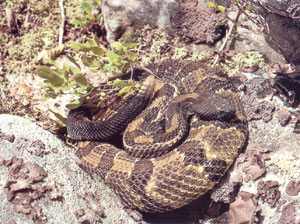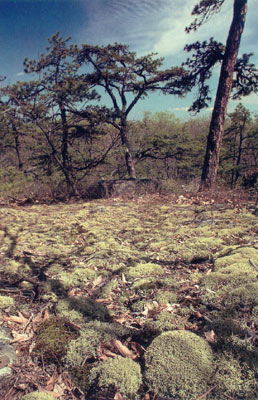Rare, Threatened and Endangered Animal Fact Sheet
Main_Content
Timber Rattlesnake | 
Timber Rattlesnake, Crotalus horridus
Photograph by Ed Thompson

Sandstone Glade,
Photograph by R. Harrison Wiegand
| Sunny sandstone outcrops like those in the Blue Ridge of Frederick County and on the Allegheny Plateau farther west provide habitat where the cold-blooded Timber Rattlesnake can warm up. Crevices in sandstone also provide habitat used by a number of other animals, including Bobcats (Felis rufus), listed as In Need of Conservation, and Allegheny Woodrats (Neotoma magister), a species considered Endangered in Maryland. Larger overhangs sheltered Native Americans in the distant past.
The Timber Rattler finds its prey through special “pits” on each side of its head that detect heat changes. Venom that destroys blood tissue is injected into prey though the snake’s fangs. The snake’s rattle, made of horny, interlocking segments, is shaken to warn away predators. Timber Rattlesnakes are shy and will usually not strike a person unless provoked. These snakes can live up to thirty years. Organized “rattlesnake roundups” deplete local populations and destroy habitat used by many other species. |
|
